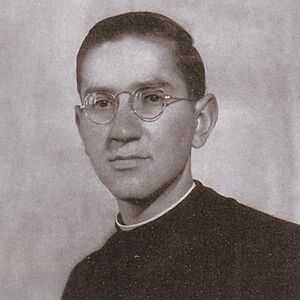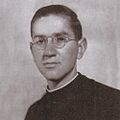Gaston Miron facts for kids
Quick facts for kids
Gaston Miron
OQ |
|
|---|---|

Gaston Miron, between 1943–1947
|
|
| Born | 8 January 1928 Sainte-Agathe-des-Monts, Quebec, Canada |
| Died | 14 December 1996 (aged 68) Montreal, Quebec, Canada |
| Occupation | Poet |
| Language | French |
| Literary movement | Quebec's Quiet Revolution |
Gaston Miron (born January 8, 1928 – died December 14, 1996) was a very important poet, writer, and editor from Quebec, Canada. He played a big role during Quebec's Quiet Revolution, a time of major changes in Quebec society.
His most famous book of poems, L'homme rapaillé, has sold over 100,000 copies. It is one of the most widely read books in Quebec's literature. Gaston Miron strongly believed that Quebec should become an independent, French-speaking country. He is still seen as the most important literary figure in Quebec's movement for independence.
Contents
Early Life and Education
Gaston Miron was born in Sainte-Agathe-des-Monts. This town is in the Laurentian Mountains, about 100 kilometers north of Montreal. His father, Charles-August Miron, was a successful carpenter. His father's death in 1940 was a very important event in Gaston's childhood.
The next year, Gaston's mother faced money problems. She sent him to study at a boarding school near Granby. This school was run by the Brothers of the Sacred Heart. Young Miron planned to become a teaching brother. However, after working for a year at a school near Montreal, he decided not to become a schoolteacher. This was the start of his journey to become a writer.
A Young Writer and the Hexagone Publishing House
In 1947, when he was nineteen, Miron moved to Montreal. At that time, Maurice Duplessis was the leader of Quebec. The Catholic Church had a lot of influence on society and culture. Miron worked for a time with a Catholic youth group called l'Order du bon temps. In the evenings, he took classes at the University of Montreal, but he did not finish his degree.
In 1953, Miron and Olivier Marchand published their first book of poems, Deux Sangs ("Two Bloods"). They published it through Éditions de l'Hexagone. This was a new publishing company started by Miron, Marchand, and four friends. Hexagone was the first publisher in French Canada focused only on poetry. Miron became the main person guiding Hexagone's work for the next thirty years.
Hexagone wanted to create a "national literature" for Quebec. They also wanted to help poets feel more connected to society. Miron quickly signed up talented young poets like Jean-Guy Pilon and Fernand Ouellette. This continued the work of older modern poets like Alain Grandbois and fr:Paul-Marie Lapointe.
From 1953 until the end of the 1950s, Miron worked in bookstores in Montreal. In his free time, he read new manuscripts and handled letters for his publishing company. He also wrote his own poetry, including La Marche à l'amour. He sometimes published his poems in newspapers like Le Devoir. Other times, he kept them to himself, working to make them perfect.
A National Poet for Quebec
When Miron returned to Montreal, he became very active in artistic and political groups. These groups often met in cafes around St-Louis Square, where he lived. His lively personality and strong speeches made him popular in the Plateau Mont-Royal area.
The poems he wrote in the early 1960s often talked about the French language in Canada. They also discussed the changing political situation in Quebec. He published some of these poems in new literary magazines like Liberté. Many of his poems were shared widely among writers and artists.
Most people did not know about his poetry until 1966. That year, Jacques Brault gave an important talk at the University of Montréal. He started by asking, "Who among us does not know Gaston Miron?" In the late 1960s, Miron took part in several poetry readings. The most famous was on March 27, 1970. This event, called "Nuit de la Poésie" (Night of Poetry), brought 4000 people to the Gesù Theatre. In 1969, Miron became the father of his only child, Emmanuelle, whom he raised.
Around the late 1960s, many of Miron's friends and colleagues encouraged him to publish his poems in a book. Even though he felt his poems were not quite ready, Miron agreed. He published L'homme rapaillé in 1970. The book quickly became a success. It included moving love poems and powerful texts about the struggles of French-speaking Québécois. Poems like La Bâteche and L'Amour et le militant were very well-written and were influenced by Quebec's oral traditions.
After his book was published, Miron was held by authorities during the October Crisis. This event made him even more dedicated to politics and to Quebec's independence. In 1975, he published another collection, Courtepointes. This book was later added to L'homme rapaillé.
The defeat of the first Quebec independence vote in May 1980 was very disappointing for Miron. During the 1980s, Miron traveled a lot, especially in France. He enjoyed visiting old friends and felt comfortable speaking French. He also appreciated the praise his poetry was receiving. The second vote on Quebec independence in October 1995 was also a close defeat. This was equally upsetting for Miron.
Gaston Miron passed away in Montreal in December 1996. He was the first Quebec author to receive a state funeral. The City of Montreal honored Gaston Miron by naming a building after him. This building on Sherbrooke Street faces Parc Lafontaine and now houses the city's arts council offices.
Works by Gaston Miron
- Deux sangs (with Olivier Marchand), Montréal, Éditions de l'Hexagone, 1953.
- L'homme rapaillé, Montréal, Presses de l'Université de Montréal, 1970.
- Courtepointes, Ottawa, Éditions de l'Université d'Ottawa, 1975.
- The March to Love: Selected Poems of Gaston Miron (International Poetry Series). Edited by Douglas Jones. Translations by Douglas Jones, Louis Simpson, John Glassco, Marc Plourde, Brenda Fleet, Dennis Egan. Athens: Ohio University Press, 1987.
- À bout portant (correspondance 1954–1965), Éditions Lemeac, 1989. These are letters exchanged between Gaston Miron and his French friend Claude Haeffely.
- Poèmes épars, collected poems from 1947 to 1995, edited by Marie-Andrée Beaudet and Pierre Nepveu, Montréal, Éditions de l'Hexagone, 2003.
- Un long chemin (d'autres proses), prose texts, edited by Marie-Andrée Beaudet and Pierre Nepveu, Montréal, Éditions de l'Hexagone, 2004.
Honors and Awards
Gaston Miron received many awards for his work:
- 1970 – Prix Québec-Paris, for L'Homme rapaillé
- 1971 – Grand Prix littéraire de la Ville de Montréal
- 1972 – Prix Littéraire Canada-Communauté Française de Belgique
- 1977 – Ludger-Duvernay Prize
- 1981 – Prix Guillaume Apollinaire
- 1983 – Prix Athanase-David
- 1985 – Molson Prize
- 1988 – Prix Fleury-Mesplet
- 1990 – Médaille de l'Académie des lettres du Québec
- 1991 – Médaille de l'Académie des lettres du Québec
- 1991 – Ordre des francophones d'Amérique
- 1996 – Officier of the Ordre national du Québec
Images for kids


